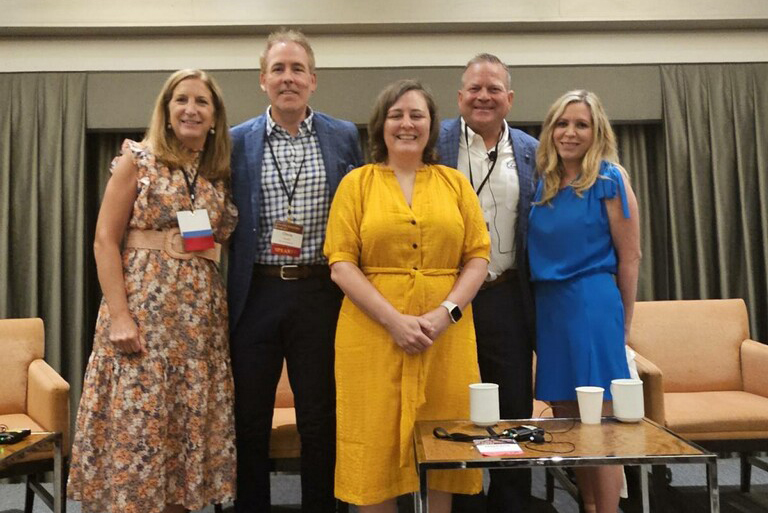CHICAGO — Senior living CEOs today face a rapidly evolving business landscape. New regulations, technology and innovation, the drive for efficiency, capital partnerships and the ground-up development dilemma are among the key issues that top leaders confront on a day-to-day basis.
A group of CEOs gathered to discuss their leading-edge strategies at the Interface Seniors Housing Midwest Conference, held June 26 at the Swissotel in Chicago. The executives participated in a session titled “The Power Panel: CEOs Discuss the State of the Industry.” Maureen Longoria, CEO and co-founder at LivNow Relocation, served as the panel moderator.
The other panelists included Chris Hyatt, co-CEO, New Perspective Senior Living; Stephanie Harris, CEO, Arrow Senior Living; Keven Bennema, CEO and founder, Charter Senior Living; and Traci Taylor-Roberts, president, Sodalis Senior Living.
The CEOs raised concerns about the rising cost of regulation. For example, a new Department of Labor regulation that went into effect July 1 makes more workers eligible for overtime pay by raising the minimum salary threshold. The impact on the bottom line for the panelists’ companies ranged from $23,000 to $1.6 million annually.
“The rule doesn’t make any sense,” said Hyatt, explaining that wage scales vary widely throughout the country. “Not one size fits all.”
Hyatt chairs the public policy committee for Argentum and urged attendees to get involved in advocacy. “Everyone in this room has a stake in the industry,” he said. “We should have 1,000 people showing up to meet with representatives and government agency officials.”
The new overtime mandate and other rising expenses can’t always be passed on to residents in the form of rent hikes, observed Bennema, especially since many operators have raised rents over the last couple years. “At some level, affordability comes into play,” he said.
To maximize efficiency, the CEOs are testing various strategies. Sodalis is leveraging technology and residents. Buffets are replacing servers in the dining room. Residents are leading community activities and giving sales tours with the help of artificial intelligence (AI). “It’s the future,” said Taylor-Roberts.
Arrow Senior Living created a “visions committee” to generate new ideas. “Tap your team,” advised Harris. Arrow hosted a “hackathon” technology event with 15 employees that resulted in the launch of a new app. It allows residents to view schedules or menus and communicate with each other. “Our operating model has to innovate,” she added.
Hyatt noted that the day-to-day whirlwind of operations leaves little time for strategic thinking. So, he hired a vice president of optimization to focus on innovation.
Technology is a big part of maximizing efficiencies, the panelists agreed. At Arrow, automation improves work flows and cuts administrative time. Fall detection systems that include predictive analytics are improving resident care. “Be a pioneer,” advised Harris.
New Perspective is using technology to gather data on care services. The data helps generate accurate bills that demonstrate to families the amount of time and services received by residents.
The panel discussed the importance of having good working relationships with capital partners. “We need to have each other’s backs,” said Bennema. He added that as the operating environment improves, data from capital partners can be leveraged to maximize day-to-day operations. Harris agreed. “We have to use data in decision making,” she said.
Moderator Longoria asked: How can providers get new development off the ground when facing relatively high interest rates and high construction costs?
For the next five to 10 years, New Perspective plans to focus on retrofitting and reconfiguring older communities. New projects are difficult to finance because of the disruption in the capital markets, according to Hyatt. “We’re bullish on renovations,” he said.
For new developments, Charter focuses on markets that others ignore, according to Bennema. Those markets are about one to two hours of travel from big markets. The company has 64 communities and three under development.
“We’ve found good land pricing and markets where the age 75 to 85 cohort is growing more than you would think,” he explained. Preleasing begins 12 months prior to project completion. “We are behind on development as an industry,” Bennema noted, acknowledging the growing number of older people who will need housing and care.
At Arrow, every line item for a new project is scrutinized. Municipalities sometimes offer development incentives, which can help bring down total costs. Little-used lounges at the end of hallways are being eliminated to help cut construction costs.
It’s important to prioritize what seniors want in a new community. “Don’t build communities for old people,” said Taylor-Roberts at Sodalis, which manages 40 properties. “People want to have fun and a sense of purpose.” Sodalis is creating spaces such as bistros, movie theaters and pickleball courts. Libraries are outmoded. “Be thoughtful,” said Taylor-Roberts.
Charter situates programming destinations throughout the community. Wellness and multipurpose spaces are a must. “Residents want what we want,” said Bennema. “Look through your own eyes. What do you want?”
— Jane Adler

